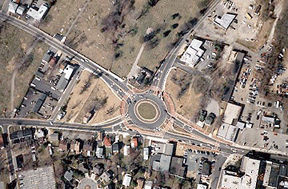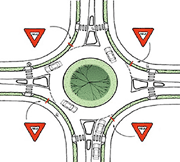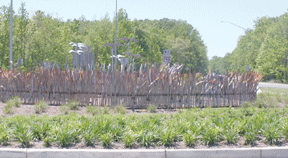
|
Volume 16, Issue 50 - December 11 - December 17, 2008
|
|
Columns |
When is the Safest Distance not a Straight Line?
At a Roundabout
by Ben Miller
Work begins at an intersection, sometimes one famed for its accidents and backups. Heavy equipment, orange cones and highway workers appear. People with flags guide your car through, but not, as you were used to for years, on a straight line.
Drivers ask: What in the world are they doing?
The answer, more often than not, is that the state highway department is building a roundabout.
Encountering a new roundabout, every driver wants to know What is this? What do I do now?
Roundabouts can be confusing — until you get used to them. And you undoubtedly will get used to them, because the state of Maryland is building more and more of them.
Why Roundabouts?
The Maryland State Highway Administration built the state’s first roundabout in Howard County in 1993. Today there are more than 60 roundabouts on state roads, according to the state’s coordinator for roundabouts, transportation engineer Mike Niederhauser.
Maryland has been a leader in the United States in building roundabouts; meanwhile, more and more states are becoming sold on their benefits.
Despite the popularity of roundabouts with highway engineers, people often react angrily to a proposal for a roundabout, says Niederhauser.
Drivers are accustomed to traffic lights. They see roundabouts as dangerous. They anticipate confusion and traffic jams.
|
Roundabout Rules of the Road

2. Keep to the right of the entry island, called a splinter island. 3. Yield to traffic in the roundabout. Traffic within the roundabout has the right of way. 4. Watch for pedestrians and cyclists in the crosswalks. 5. Enter the roundabout to the right. Drive counterclockwise. 6. Exert your right of way once in the roundabout. This keeps traffic moving. 7. Put on your right turn signal as you approach your exit. 8. Exit to the right. 9. Special caution for two-lane roundabouts: • watch for cars beside you • when exiting from the inside lane, stay alert for vehicles in the right lane. Adopted from the brochure Roundabouts, How to Drive, Walk or Bike Maryland’s Roundabouts by the State Highway Administration of the Maryland Dept. of Transportation. For more information check www.marylandroads.com and search roundabouts. |
They’d feel worse if they knew that their confusion was costly. It is cheaper to install a traffic signal at $200,000 than to build a roundabout, which can cost from $1 to $2 million. Often additional rights of way must be purchased, and construction can take months.
So why has the state of Maryland built so many roundabouts — with five to 10 more in the works?
The answer, in one word, is safety.
Roundabouts Are Safer
Roundabouts are “a life saver in Maryland,” said David Buck, Maryland State Highway Administration spokesman. “The results are there.”
These results are impressive. At state road intersections where roundabouts have been built, there has been a 100 percent reduction in fatal crashes, an 85 percent reduction in injury crashes and a 60 percent reduction in total crashes. Simply, that means no deaths since 1993.
Crashes at roundabouts are usually fender benders with no personal injuries, Niederhauser said, citing several reasons for this safety record.
First, a roundabout slows traffic. Vehicles move through roundabouts at 15 to 20 miles per hour instead of the 50 to 60 miles per hour through a green traffic light.
Second, roundabouts reduce what highway engineers call conflict points. Right-angle accidents — where one vehicle broadsides another — are typical of T-intersections with traffic lights. The possibility of death or injury is high.
“The traffic light is our most dangerous intersection,” says Niederhauser.
In a roundabout, most collisions occur at a lesser angle and at slower speeds.
Third, drivers need only look in one direction — to the left — when entering a roundabout. At a T-intersection, especially at a stop sign, a driver looks in at least three directions — and often rechecks — before pulling out. “Drivers’ responsibilities become much simpler,” Niederhauser said.
A fourth reason is that aggressive drivers are slowed and controlled by roundabouts. The design of the roundabout forces everyone to slow down.
Transportation officials tout roundabouts as safer for cyclists, too. “Cyclists like roundabouts because they are equals,” said Niederhauser. Within the roundabout, cyclists have the right of way over entering cars, and at 15 and 20 mph get through the intersection at about the same speeds. Single lane roundabouts are safer for cyclists.
But not every cyclist agrees.
Bay Weekly columnist Steve Carr, a bicycle commuter, reports finding “them dangerous and unwieldy for cyclists, who must stop, wait, stop, wait, stop, wait, as they move forward in line, then go from a stop to inserting themselves into the constant merging flow.” Worse, he said, “cars generally ignore an oncoming cyclist and simply cut out in front of us.”
Traffic Flows Round the Roundabout
In addition to calming traffic, roundabouts have another advantage over traffic signals. They improve traffic flow. Although traffic can back up at a roundabout, just as at a traffic light, vehicles keep moving round. A driver doesn’t have to wait for a red light. If there are no vehicles ahead and none in the roundabout, the driver can move on through. Once within the roundabout circle, a driver has the right of way.
“Don’t yield within a roundabout,” Highways spokesman Buck says. “People can be polite, but to keep traffic moving don’t stop within the circle. Exert your right of way. The key is the flow.”
Roundabouts work especially well at the intersections of two-lane roads. A vehicle turning left no longer blocks everyone behind but moves through the circle in turn.
Roundabouts reduce the number of idling cars waiting for a light. This cuts air pollution.
Power outages don’t affect roundabouts. They have no traffic signals to go out. Traffic keeps moving.
The absence of traffic lights is one reason that — although the initial cost of a roundabout is higher than a traffic light — the cost of upkeep is less.
One Up on Traffic Circles
The modern roundabout is a new, improved take on the old traffic circle.
Traffic circles predate cars in places like Annapolis and Washington, D.C., where the increased volume of traffic gave them a bad name by the 1950s. Some of the old traffic circles, unlike roundabouts, gave entering traffic the right of way.
Traffic circles, unlike roundabouts, often have a complex mixture of traffic lights, stop signs and yield signs controlling entry and even stopping traffic within the circle. Dupont Circle in Washington, D.C., and Church Circle in Annapolis are examples of traffic circles with lights. These are not roundabouts. An Annapolis example of a true roundabout is Westgate Circle at the intersection of Taylor Avenue, West Street and Spa Road. Traffic circles also permit pedestrians to walk onto their central island, while roundabouts do not, cutting down on distractions for drivers.
| The Empty Center
Since the Lothian roundabout introduced the new traffic circle to Chesapeake Country in 1995, Bay Weekly has crusaded for filling the empty centers of roundabouts with statues, fountains and plantings of bushes, trees and wildflowers. A Bay Weekly editorial in September, 2006, cited examples of Bath, England; Milan, Italy; Hamilton, New Zealand; Nashua, New Hampshire; and Golden, Colorado, of cities with elegant roundabouts. So far, the village of Deale is the only community to spruce up the center of its roundabout, adding lush plantings and copper sculptures of marsh plants and waterfowl. The effect is transforming. A once sluggish intersection is an artistic introduction to a waterfront community.
|
The new roundabouts have tighter turns than the old traffic circles. This is deliberate, according to Buck, to slow traffic. The curb is designed as mountable for truckers making the tighter turn.
Roundabout in Anne Arundel and Calvert
Deale’s roundabout — at the intersection of the Deale-Churchton Road (Route 256) and Bay Front Road East (Route 258) — was finished in 2007.
Business people welcomed it as an opportunity. The Deale Merchants Association created a gateway for its new roundabout, an introduction to the community. Copper sculptures of marsh plants and landing waterfowl, plantings and memorials let people know they are entering the town of Deale. The roundabout also modernizes a crossroads complicated by entrances to businesses and challenging for drivers, cyclists and pedestrians.
It works, drivers say.
David J. B. Jochnowitz of Barnes Park Landscape Development designed and built the waterfowl and marsh grass sculpture, but he likes the roundabout for another reason — it saves him time.
When returning to his West River home from the Washington area, Jochnowitz says the roundabout eliminates what was once as much as a 10 to 15 minute wait to turn left from Route 258 onto Route 256.
Safety was the reason for another 2007 roundabout built no more than 10 miles away. People died at the intersection of Route 2 and Friendship Road in Anne Arundel County.
“For two years straight, the intersection ranked high in accidents,” Niederhauser said. The decision to build was based on “accident location studies,” he said.
Highway funds are prioritized to intersections that statistics indicate are particularly dangerous.
The economic downturn and state budget concerns will delay new construction projects. There will be no new roundabouts in Anne Arundel and Calvert counties for the next year or so, according to Niederhauser.
An upgrade of the roundabout at the intersections of Routes 2, 408 and 422 near Lothian in Anne Arundel County is proposed. Northbound traffic continuing on Route 2 will have what Niederhauser called a free right to pass through the intersection without entering the roundabout. This will help the flow of truck traffic especially. A truck’s start-up time from a stop is much longer than that of a passenger vehicle.
In Calvert County near Lusby, a new roundabout keeps an old crossroads up with recent rapid development that has transformed the sleepy intersection of Trueman Road (Route 765) and Rousby Hall Road (Route 760) into a bustling town center with four separate modern shopping centers with shopping and popular restaurant franchises.
Driver Confusion
There are drawbacks to roundabouts, at least when they first go in.
People often react negatively to any roundabouts, said highway spokesman Buck.
Typical is long-time Baltimore resident Sonny Hersch: “Whenever I come to a roundabout, I say, ‘What do I do? Where do I go?’ My wife starts to point and say, ‘Go there! Go there!’”
Yet once people get accustomed to the roundabout, “communities quickly come around,” said Buck. “Even in communities that have resisted, the roundabouts are afterwards well received. Public perception is shifting.”
Niederhauser agrees. “People will say we don’t want that thing. We want a traffic light,” he said. “Then once the roundabout is built, and drivers get used to it, they’ll ask for another.”
